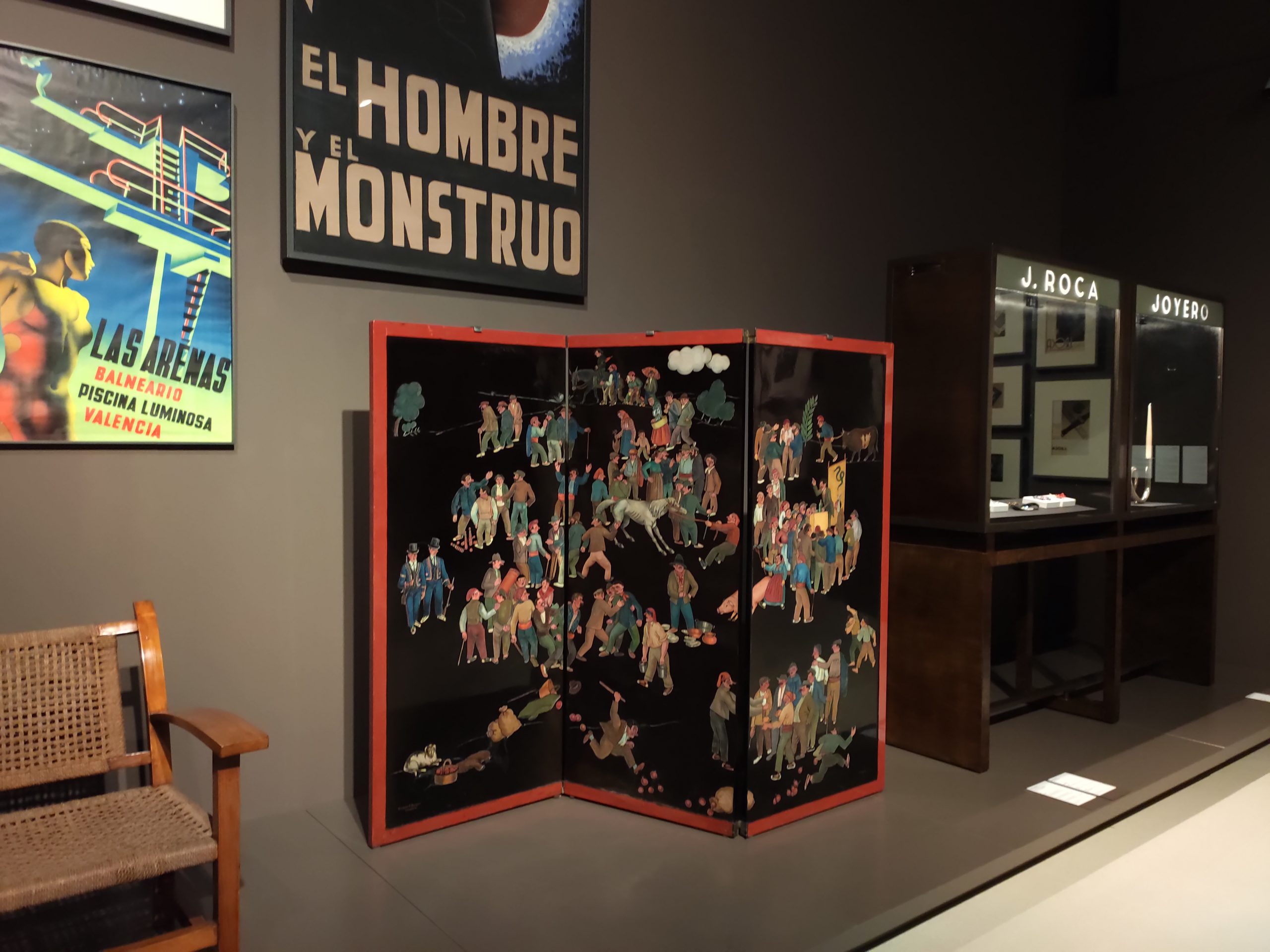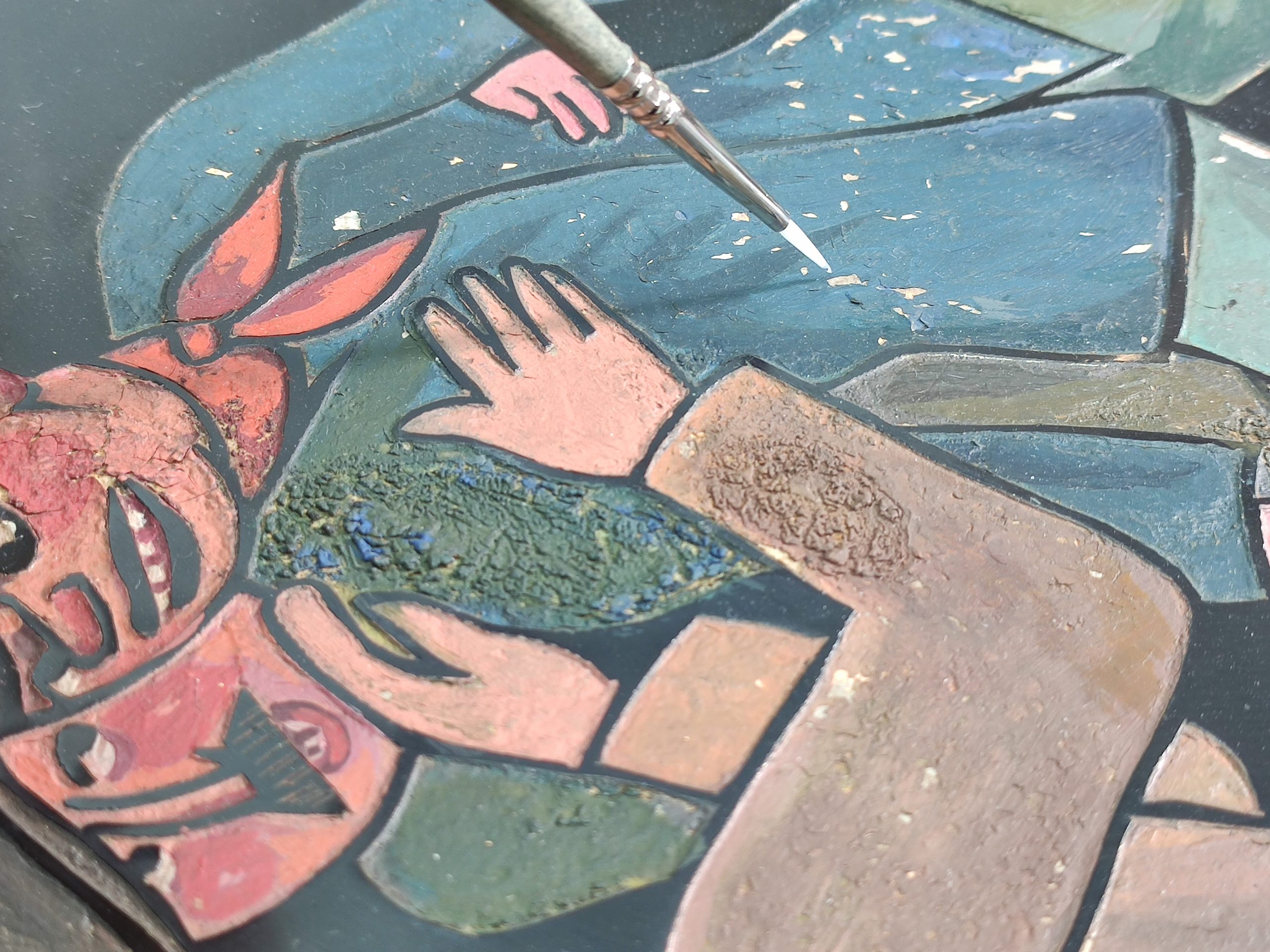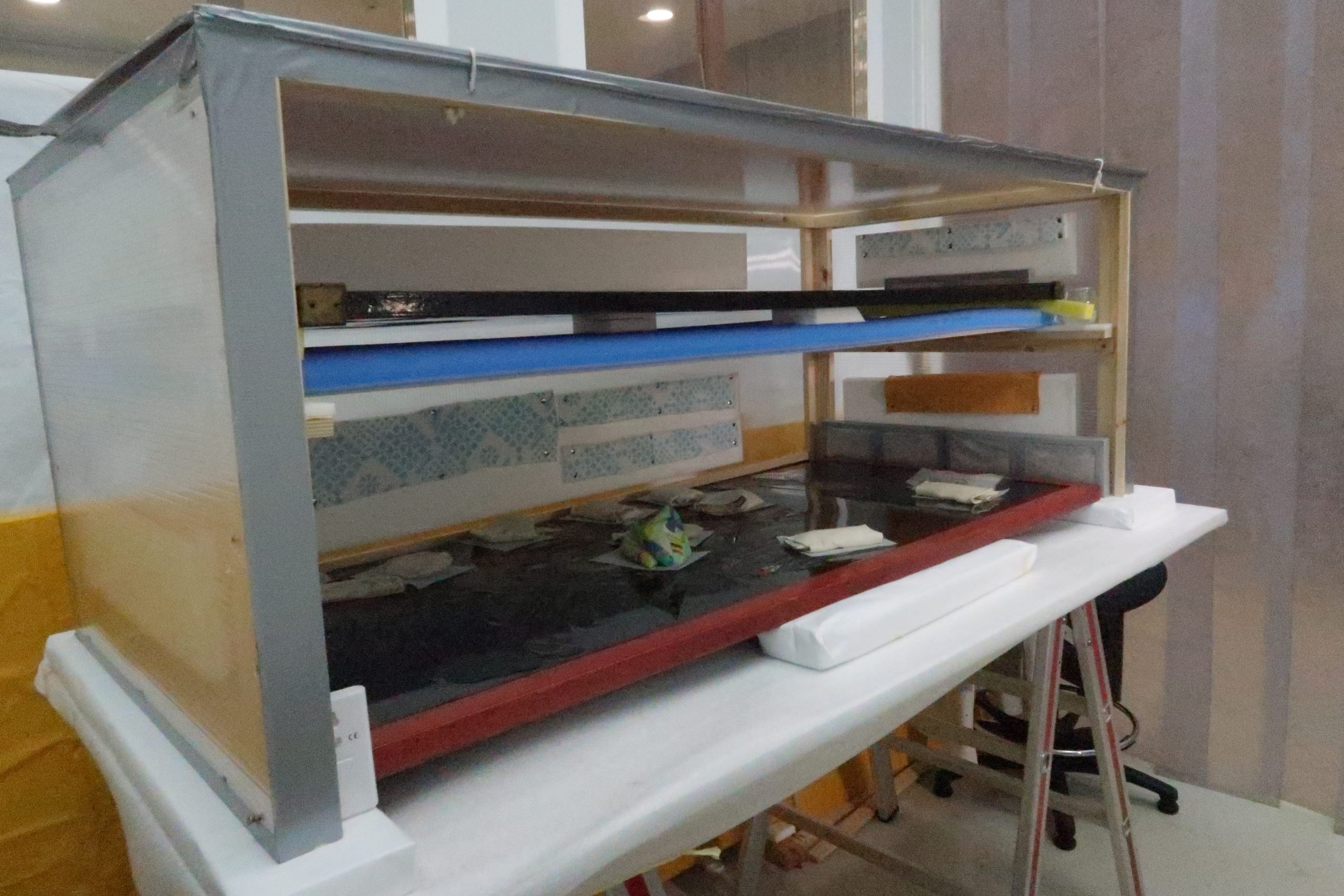Núria Prat and Teresa Sardà
Calaf Market is a work that has recently been placed in one of the rooms in the museum, on loan since 2019 from a private a collector. It is a folding screen signed by the lacquer artist Enriqueta Pascual Benigani, and also by Xavier Nogués, who did the caricature drawing that was used as the basis for the painted parts.
Front and back of the folding screen after the restoration work. ©Museu Nacional d’Art de Catalunya
The illustration must have been popular at the time – it was witty and likable – since it was reproduced in several publications, such as Revista Nova (1914) and Catalunya Pintoresca (1919). In 1929 a photograph of the screen appeared in the magazine D’Ací i d’Allà.
The version of “Calaf Market” reproduced in Revista Nova in 1914 / The version of “Calaf Market” reproduced in the magazine D’Ací i d’Allà in 1919, which looks more like the folding screen.
A work with an unusual technique
The combination of different techniques – urushi lacquering, engraving and oil painting – in a design on a popular theme such as this, costumbrista and caricatural, makes the folding screen an especially interesting, exceptional piece. It should be borne in mind that pieces lacquered with urushi, mainly decorative objects and furniture, generally reproduced designs typical of Japanese art, inspired mostly on nature, although Catalan lacquerers always made their works with genuine western designs.
Details of the scene reproduced on the folding screen: the elixir seller, the group of men talking, the women with the pig, the one with the hens, the man with the horse, the thief and the pair of mossos d’esquadra. ©Museu Nacional d’Art de Cataunya
A look at the interior of the folding screen: the wooden structure
Calaf Market is a triptych of wooden panels measuring 148.4 x 188 x 3 cm, each of them joined to the next one by two metal hinges. The two lateral panels are 64 cm wide and the central one is 60 cm. Each panel is made up of two plywood boards attached to a stretcher that acts as the frame. Thanks to an X-ray study, we know that a thin plain-weave cloth was stretched over the entire surface of the plywood boards, and this is why they are said to be clothed.

Installation of the folding screen in Modern Art room 74. ©Núria Prat
A two-handed restoration
Due to the mixed composition of this work, two conservator-restorers worked on it: a specialist in urushi lacquering and another in painting. Dialogue and understanding between both of them were essential for getting to know the materials and the technique, and establishing the working methodology that was suitable for carrying out the restoration successfully. In this case, minimal intervention was the criterion adopted in order to guarantee the stability and the preservation of the work of art.
Teresa Sardà has restored the urushi lacquer / Núria Prat has restored the oil paint decorations. ©Núria Prat i Paz Marquès
The folding screen had already been restored!
The first surprise in the restoration process was detecting elements that revealed previous interventions. In the lacquer, breaks in the surface layer caused by excessive pressure and also by the application of materials alien to urushi. In the case of the paintings, we saw evidence of retouches in which the colours had been changed. After making a few attempts at cleaning it was decided not to remove them due to the risk of damage that these actions might entail.
Detail of losses of colour. ©Núria Prat
State of preservation of the oil paintings
The motifs by Xavier Nogués are carved on the black lacquered surface and painted with oils in the grooves this left. It should be mentioned that on all three panels one sees the same kinds of damage: surface dirt, very dry paintwork, colour instability with flaking, chromatically altered retouches and small losses of colour, and various stains.
Losses and deteriorations of the lacquered surface that left the cloth exposed. ©Teresa Sardà
The challenge: how to fix the unstable oil paint without damaging the urushi or the interior materials?
The oil paint decorations are right next to the lacquer: the black outlines that sketch the figures (hair, clothes, faces) were done originally with urushi. This proximity of the two techniques conditioned the working methodology and we had to be extremely cautious when choosing the materials to do compatible restoration work. It was a real challenge to fix the unstable colour with an adhesive that did not alter the work as a whole. Due to the delicate and controversial situation we could not do tests that might damage the work; right from the start it had to be tackled with the right adhesive or glue.
It should be pointed out that the work of the conservator-restorer is not just manual, but also conceptual: you have to know what to do and how. It is vital to know the materials, how to apply them and how they interact with one another and with the work of art.
A peculiarity of the painted decorations on this folding screen is that they are completely matt. The analyses carried out have confirmed that it is oil paint, although from its visual appearance it does not look like it. Therefore, the adhesive used to fix the colour had to leave this singularity unchanged.

Adhesion of the colour with the funori alga. ©Núria Prat
To fix the unstable colour, the funori alga was used
The properties of this alga made it possible not to interfere with the characteristics of the surface paintwork, since it is an adhesive that ages well, it is stable and it does not alter the colours. Funori adheres the colour without it being necessary to apply too much humidity to the surface. The mucilage contained in the alga makes this adhesive flexible and at the same time consistent.
Urushi lacquer: what it is and how it came to Europe
This technique was introduced to Europe in the early 20th century as a result of the presence of Japanese lacquer artists at the Universal Exposition in Barcelona in 1888 and the one in Paris in 1900. It gained momentum in the art deco period with different Catalan lacquer artists, including Lluís Bracons and Enriqueta Pascual Benigani.



Detail of the coromandel technique: on a surface of black lacquer the most superficial layer is removed according to a drawing that is then painted with different coloured tempera or oil paint / Detail of the negoro technique: surface lacquered with alternate layers of black and red on which patches appear when they are polished / Detail of the Iro-urushi technique: a layer of coloured lacquer obtained with aka-Roiro resin and vegetable pigment; the black lacquer, Kuro-Roiro, is obtained with the oxidation of the virgin resin ©Museu Nacional d’Art de Catalunya
Urushi is a resin extracted from the tree Rhus verniciflua, whichgrows mainly in China and Japan. It is the result of a filtering and production process and, properly treated, it provides various kinds of lacquers for use in different techniques. Three different techniques have been used in this folding screen:: the ones called coromandel on the front; negoro, on the back; and iro-urushi on the frame, red lacquer on the front and black lacquer on the back.
Study of the urushi lacquer and state of preservation
The analyses carried out determined that this piece had been lacquered according to the urushi lacquering procedure that is practised in Japan. The most noticeable sorts of damage in the lacquered areas were the general ageing of the very dry components, with all sorts of dirt, scratches, flaking and breakages, and detachments and losses of material caused by knocks, cracks and also by previous restoration work.
Microscope image with ultraviolet light of a section of black lacquer that was analysed. Six strata have been identified before reaching the cloth, in this case cotton. Analyses by Núria Oriols ©Núria Oriols
The restoration of the urushi lacquer
It is advisable to restore pieces of urushi with the same materials, that is, with urushi, following the guidelines and the techniques corresponding to the affected parts. Its characteristics of hardness, flexibility, adhesion, impermeability, etc., make it somewhat incompatible with other materials. For the lacquer that is incorporated in the work to harden properly, one must be extra careful with the atmospheric conditions, and for this reason a receptacle – a box or furo – was made, which in Japan is called urushiburo.

The furo or urushiburo is a cupboard in which a suitable atmosphere is created that hardens the urushi lacquer that is incorporated in the work. In this case, it is urushiburo shimeshiburo: moist material is arranged inside it to artificially raise the relative humidity ©Núria Prat
The consolidation of the urushi lacquer
With regard to the consolidation of the flaked lacquer, extreme precaution was necessary, because upon exerting pressure, due to the hardness of the urushi, the layer does not always give way and it might break. The pressure must therefore be produced slowly and gradually. In some cases it was not possible to press the flaked areas of the lacquer down to level the surfaces, due the risk of breakage. It was then decided to fill and seal the cracks by applying the same materials and techniques, in order to prevent any humidity getting in.
Urushi is always hungry!
The last action on the folding screen consisted of providing the layers of food that urushi requires (suri-urushi) in order to preserve it. It should be pointed out that, as time passes, works containing this resin dry out and even crack. To prevent the urushi lacquer from ageing it will be necessary to feed it periodically to give the surface layers elasticity.
Application of the layers of food for the urushi lacquer ©Núria Prat





















